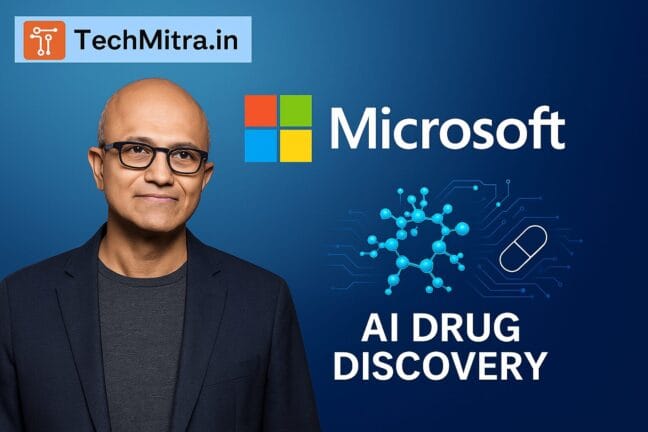
Table of Contents
In a groundbreaking announcement that marks another milestone in AI for healthcare, Microsoft CEO Satya Nadella has unveiled BioEmu, a revolutionary AI initiative aimed at transforming drug discovery. Developed by Microsoft Research’s AI for Science team, BioEmu is poised to bring major breakthroughs in understanding how proteins behave, potentially accelerating the development of life-saving drugs for complex diseases like cancer, Alzheimer’s, and autoimmune disorders.
In this article, we dive deep into what BioEmu is, how it works, its significance for pharma and biotech industries, and what Satya Nadella envisions for the future of AI in healthcare.
What is BioEmu?
BioEmu is Microsoft’s advanced AI model designed to predict the conformational changes in proteins.
In simpler words, proteins inside our body are not static; they fold, twist, and move into different shapes to perform their functions. These movements, called conformational changes, determine how proteins interact with other molecules, how they bind to potential drugs, and how diseases progress.
Understanding these shapes has been a major challenge in structural biology. Traditional methods like X-ray crystallography or cryo-electron microscopy take months or even years to determine a single protein structure. BioEmu uses AI-powered molecular simulation and prediction capabilities to reduce this timeframe significantly.
Why did Microsoft build BioEmu?
Satya Nadella, while announcing BioEmu, emphasised that AI’s true potential lies in empowering scientific discovery.
Here are the key reasons why Microsoft developed BioEmu:
- To accelerate drug discovery by predicting protein structures and behaviours faster than ever
- To help researchers understand diseases at a molecular level with high accuracy
- To integrate AI with cloud and quantum computing for next-generation biological research
- To reduce drug development costs by identifying potential failures at early computational stages rather than in expensive clinical trials
How does BioEmu work?
BioEmu has been developed by Microsoft’s AI for Science team, the same group behind their molecular simulation initiatives. It leverages:
Deep learning algorithms trained on massive datasets of protein structures
Physics-informed neural networks to simulate how proteins fold and change shapes dynamically
Integration with Azure Quantum Elements, Microsoft’s platform that combines AI, cloud, high-performance computing, and quantum technologies for scientific research
According to the announcement, BioEmu can predict multiple conformations of a protein, rather than giving a single static image. This is crucial because drug binding often depends on transient or rare shapes proteins adopt during their function, which are difficult to capture experimentally.
Why is predicting protein conformations important?
Most existing AI models, like DeepMind’s AlphaFold, predict the most stable structure of a protein. However, proteins rarely stay in just one shape. Their function depends on continuous movement and transitions among different conformations.
For example:
Enzymes change shape to catalyse reactions
Ion channels open and close in different conformations
Disease-causing proteins, like those forming amyloid plaques in Alzheimer’s, misfold into harmful shapes
BioEmu’s ability to predict these dynamic conformations can help scientists:
- Design better drugs that fit specific protein shapes
- Understand disease mechanisms at an atomic level
- Reduce side effects of drugs by targeting precise conformations
How is BioEmu different from AlphaFold?
AlphaFold, developed by Google DeepMind, made headlines in 2020 by predicting static 3D structures of proteins with remarkable accuracy, revolutionising structural biology. BioEmu takes this further by:
- Predicting not just static structures but dynamic conformations
- Simulating molecular behaviours under physiological conditions
- Integrating predictions with Microsoft’s quantum computing research, aiming for even more precise modelling in the future
While both models are breakthroughs, BioEmu’s focus on protein dynamics rather than static snapshots could unlock a new dimension in drug discovery.
Microsoft’s vision for BioEmu and AI in Science
During the announcement, Satya Nadella said:
“Our mission is to empower scientists with AI tools that can accelerate discovery in ways that were previously unimaginable.”
He added that BioEmu is part of a larger initiative to build a ‘Copilot for Science’, similar to how Microsoft has integrated Copilot in Office and coding. The idea is to create AI models that assist researchers in:
Designing experiments
Generating hypotheses
Predicting molecular behaviours
Analysing complex biological datasets
Potential impact on pharma and biotech industries
The pharmaceutical industry currently takes 10-15 years and billions of dollars to develop a single successful drug. By integrating BioEmu in early research stages, companies can:
- Identify promising compounds faster
- Eliminate non-viable candidates early, saving massive costs
- Design targeted therapies with greater precision
- Develop treatments for diseases with no current cure, by understanding their molecular basis better
Moreover, biotech startups and academic researchers can access these AI tools via Microsoft’s Azure platform, levelling the playing field and democratising drug discovery.
Challenges ahead
Despite the optimism, experts caution that:
AI predictions must be validated experimentally before moving to clinical development
Data biases or inaccuracies in training datasets can lead to misleading results
Ethical frameworks are needed to ensure responsible use of AI in biology
Microsoft, however, is working with leading academic labs and pharmaceutical companies to ensure BioEmu’s outputs are reliable, ethical, and beneficial for humanity.
The road ahead for BioEmu
BioEmu is currently being rolled out to select research partners, with plans for wider availability via Azure Quantum Elements and Microsoft’s scientific AI platforms in coming months.
Satya Nadella’s announcement marks not just a product launch but a vision for the future where AI becomes an essential partner in scientific breakthroughs, enabling:
Faster vaccine development
Personalised cancer therapies
Treatments for currently incurable genetic disorders
Conclusion
With BioEmu, Microsoft is entering a new era where AI transcends its role in coding, writing, or business analytics, becoming a force multiplier for science itself.
If successful, this could lead to a future where discovering new drugs is no longer a decade-long process but an accelerated journey powered by AI, cloud, and quantum technologies working hand in hand.
Satya Nadella’s bold vision with BioEmu may well redefine the boundaries of what AI can achieve for humanity.
